
Ready to feel ab-tastic? Reach for a set of medium-size weights to work both the arms and the core.
Click here for a printable PDF version of the workout.
Original article and pictures take media1.popsugar-assets.com site

Ready to feel ab-tastic? Reach for a set of medium-size weights to work both the arms and the core.
Click here for a printable PDF version of the workout.

Jump To A Page ---------------- Series Main Page Series Overview Getting Started ---------------- Week 1 Week 1, Day 1 - Upper Body A Week 1, Day 2 - Lower Body A Week 1, Day 3 - Caloric Intake Week 1, Day 4 - Upper Body B Week 1, Day 5 - Lower Body B ---------------- Week 2 Week 2, Day 6 - Upper Body A Week 2, Day 7 - Lower Body A Week 2, Day 8 - Choosing Foods: Proteins Week 2, Day 9 - Upper Body B Week 2, Day 10 - Lower Body B ---------------- Week 3 Week 3, Day 11 - Upper Body A Week 3, Day 12 - Lower Body A Week 3, Day 13 - Choosing Foods: Carbs Week 3, Day 14 - Upper Body B Week 3, Day 15 - Lower Body B ---------------- Week 4 Week 4, Day 16 - Upper Body A Week 4, Day 17 - Lower Body A Week 4, Day 18 - Choosing Foods: Fats Week 4, Day 19 - Upper Body B Week 4, Day 20 - Lower Body B ---------------- Week 5 Week 5, Day 21 - Upper Body A Week 5, Day 22 - Lower Body A Week 5, Day 23 - Foods & Cooking Basics Week 5, Day 24 - Upper Body B Week 5, Day 25 - Lower Body B ---------------- Week 6 Week 6, Day 26 - Upper Body A Week 6, Day 27 - Lower Body A Week 6, Day 28 - Eating at Restaurants Week 6, Day 29 - Upper Body B Week 6, Day 30 - Lower Body B ---------------- Week 7 Week 7, Day 31 - Upper Body A Week 7, Day 32 - Lower Body A Week 7, Day 33 - Cardio While Bulking Week 7, Day 34 - Upper Body B Week 7, Day 35 - Lower Body B ---------------- Week 8 Week 8, Day 36 - Upper Body A Week 8, Day 37 - Lower Body A Week 8, Day 38 - Warming Up & Stretching Week 8, Day 39 - Upper Body B Week 8, Day 40 - Lower Body B ---------------- Week 9 Week 9, Day 41 - Upper Body A Week 9, Day 42 - Lower Body A Week 9, Day 43 - Sleep & Recovery Week 9, Day 44 - Upper Body B Week 9, Day 45 - Lower Body B ---------------- Week 10 Week 10, Day 46 - Upper Body A Week 10, Day 47 - Lower Body A Week 10, Day 48 - Supplements Week 10, Day 49 - Upper Body B Week 10, Day 50 - Lower Body B ---------------- Week 11 Week 11, Day 51 - Upper Body A Week 11, Day 52 - Lower Body A Week 11, Day 53 - Injuries & Setbacks Week 11, Day 54 - Upper Body B Week 11, Day 55 - Lower Body B ---------------- Week 12 Week 12, Day 56 - Upper Body A Week 12, Day 57 - Lower Body A Week 12, Day 58 - Tracking Progress Week 12, Day 59 - Upper Body B Week 12, Day 60 - Lower Body B
Bodybuilding.com presents your 12-Week Daily Bulking Trainer! Day by day, we'll help you build lean mass and forge a ripped, defined physique. You'll learn about setting goals, training for extreme muscle growth, following a proper nutrition plan, bulking supplementation, and staying motivated. All the knowledge you need to succeed is at your fingertips.
Welcome to the Bodybuilding.com 12-Week Daily Bulking Trainer, your solution to building lean muscle the right way!
Total Calories: 15 Calories / Pound of Body Weight
Protein: 1 Gram of Protein = 4 Calories
You should take in 1 gram of protein per pound of bodyweight.
Fats: 1 Gram of Fats = 9 Calories
You should take in .5 gram of healthy fats per pound of bodyweight.
Carbs: 1 Gram of Carbs = 4 Calories
The rest of your calories should come from carbs.
Supplements will never replace training, rest and proper nutrition. But they can help you reach your goals as quickly as possible. Without your hardwork supplements won't work.
The best supplements to start with are:
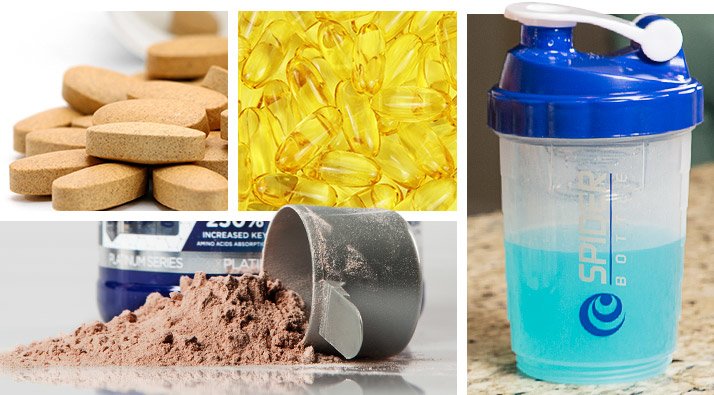
You should also consider performance supplements such as:
An all inclusive pre-workout supplement is also vital. Last but not least are BCAA's which are great for muscle recovery.
Maximize your results and prevent injury by stretching every day.
Whenever you are at the gym there are a few things you're going to want to have with you:

Today is yoga day at SkinnyMs. Fitness. It’s important to take a day to stretch, work on balance and relax your mind & body. I’ve chosen a full yoga session for beginners. You will need water and a yoga mat. Namaste!
This class is 20 minutes.
Exercise and health are matters that vary from person to person. Participants of the daily workout should speak with their doctors about their individual needs before starting any exercise program. This Web site is not intended as a substitute for the medical advice and supervision of your personal physician. Any application of the recommendations set forth in the following pages is at the viewer’s discretion and sole risk. See your physician before beginning any exercise program. This is especially important if your family has a history of heart disease, high blood pressure, high cholesterol, diabetes, arthritis, obesity, cigarette smoking, or other health conditions. If you have any doubts whatsoever, consult your physician. Please submit feedback using our Contact Page.
So you killed leg day, but now you can’t even walk to the bathroom without being in pain. Post-workout muscle soreness is both a good thing and a bad thing. It’s a good thing because that indicates that you had a successful, muscle-building workout. Soreness is caused by the micro-tears in the muscles from working really hard. If you are sore, good job! You are building muscle.
Unfortunately, muscle soreness is can also be pretty uncomfortable- even painful- and also quite inconvenient in a lot of situations. If you work out a lot, you are going to be sore all the time, and that’s just no fun.
Here are yoga poses for post-workout muscle soreness. These poses will help ease muscle soreness, as well as increase your mobility & flexibility for your future workouts.
Standing Forward Bend
Clasp your hands together behind your back, hinge forward at the hips, let your head hang, and bring your arms overhead. Sway slowly from side to side, letting the weight of your arms stretch your shoulders at different angles.
Standing Side Bend
Stand with your feet together and your arms overhead with your palms together. Keeping your arms straight- or close to straight- lean to the left and right, taking the time to feel your sides open.
Wide Legged Forward Bend Twist
Stand with your feet placed 3-4 feet apart, and hinge your torso forward at the hips. “Roll” your spine down and rest your hands on the floor, letting your neck & head relax. Bring one arm upwards and look up at it, feeling your spine twist and open. Switch arms and repeat.
Standing Forward Bend
Stand with your feet together, and bend over, “rolling” your spine down as you reach towards the floor. Let your neck relax and your head hang.
Reclining Bound Angle Pose
Start in an upright (sitting) Bound Angle Pose (the “butterfly” stretch), then roll your spine back until your are laying down. This will stretch your hip flexors (and ladies take note, this pose is also great for relieving menstrual cramps).
Camel Pose (Ustrasana)
Begin on your knees, with your arms at your side, looking straight forward. Slowly draw your arms up over your head, then using one arm at a time, reach your hands behind you to grasp your heels. Make sure your hips are positioned over your knees, then relax your neck and shoulders so your head hangs back and your throat feels “open”.
Crescent Lunge
Start in a high lunge, then slowly lower the back knee down to the floor. Keep your torso to an upright position, and make sure your front knee does not extend forward over your toes.
Wind-Relieving Pose
Lay with your back flat on the ground and legs fully extended. Bring both knees in towards your chest, clasp your hands around your legs, and round your back so your buttocks come slightly off the floor. Attempt to bring your forehead to your knees, then rock slowly from side to side to gently massage your spine.
Two Knee Spinal Twist
Lay with your back on the ground, and your knees bent. Let your knees fall to one side, and look in the opposite direction, with your arms extended to both sides.
Childs Pose
Sit with your knees slightly apart and folded underneath your body, then lean forward to rest your forehead on the ground. Rest with your arms by your sides, or increase the stretch by reaching your arms forward.
Plow Pose
From a sitting position, roll your spine backwards and down to the floor, and bring your knees into your chest. Place your hands on your lower back for support as you extend your legs upward towards the ceiling. Finally, lay your arms on the floor when you are stable, lower your legs down towards your face, and aim to touch your toes to the floor above your head.
Downward Dog
Stand with your feet together, hinge forward at the hips, and bend your knees so that your palms are flat on the floor (if they aren’t already). Shift your weight so that your arms are supporting you as you hop or walk your legs back. Use your hands to push your body back towards your heels until you feel a stretch throughout your back and legs
Side Plank Pose
Starting from either Plank Pose or Downward Dog (whatever you are more comfortable with) shift your weight to one arm, and rotate your body to the side. Engage your core and lift your hips upwards, and extend your free arm overhead.
Sphinx Pose
Lay on your stomach and place your elbows below your shoulders. Prop yourself up on your forearms, taking care to keep your shoulders down and away from your ears.
Cobra Pose
Lay on your stomach and place your hands flat on the floor beneath your shoulders. Slowly press up with your arms, straightening them only to the a point that is still comfortable for your back. Take care to keep your hips on the ground, and your shoulders away from your ears.
Check out the second installment of our yoga for athletes series. This second video focuses more on moving the body to wash out any tightness or stiffness you athletes get after an intense training session. Once again, Heather Lorince brings the yoga in a fun and relatable way!
Reflexion Yoga offers beginner yoga, yoga classes, yoga workouts, yoga poses, yoga postures, yoga exercises, yoga for weight loss, online yoga, power yoga, vinyasa yoga, restorative yoga, yoga for athletes, a yoga blog, yoga for beginners, and a HUGE library of yoga videos, all at at a fraction of the costs of a yoga studio!
Start your 30-Day FREE Trail today!
CLICK HERE: https://reflexionyoga.com/sign-up/
Subscribe to our channel and get started! New videos being added all the time!
Be Light,
The Reflexion Yoga Team
P.S.: Share this video with your friends on Facebook and Twitter!!
After yoga, I really love running but my hamstrings can get pretty tight. Here I'll show you some really effective yoga poses for after a run. Check out these three postures and get loose!

Now that the holidays are here, we are becoming bombarded with holiday treats and might find yourself a little bloated and backed up. With the help of yoga, your body can process all that food a little easier.
1. Seated Forward Fold
Begin seated on your mat, with your legs straight out in front of you. Breathe in and straighten your spine, like you are sitting up, then exhale reaching for your toes. Hold for 5-10 breaths, reaching further with each breathe.
2.Cat and Cow
Begin the same way as downward dog, on your hands and knees with wrists beneath your shoulders and your knees below your hips, with a neutral spine. Inhale and shift your gaze to the sky, dropping your belly slightly. Exhale and drop your head and round your back, spreading your fingertips wide. Repeat for 5-10 breaths.
3. Childs Pose
Begin kneeling, knees hip distance apart with the tops of your feet on the ground. Bend forward reaching towards the edge of the mat and spread your fingers wide. Relax your shoulders away from your ears, feeling a stretch down your spine. Continue to reach forward with each breath. Hold for 5-10 breaths.
4. One-legged seated twist
Begin seated on your mat, with your legs straight out in front of you. Twist your body towards your right leg, and take your left leg and place it on the outside of your right leg, bending it so your foot can rest on the ground. Squeeze your leg and hold for 5-10 breaths. Repeat with your right leg.
5. Pigeon Pose
Start in down dog. Exhale, bringing your left knee to your left elbow and left ankle to right wrist on your mat. Fold forward over your left leg, feeling your spine lengthen. Hold for 3 breaths.
By warming up your body, your muscles can relax and that will help assist your “inner flow” and get things moving again. Namaste.
Big day at the gym? Long run? Every athlete gets sore. Use this video to stretch out and loosen up so you can recover faster and get back on your A-game!
Reflexion Yoga offers beginner yoga, yoga classes, yoga workouts, yoga poses, yoga postures, yoga exercises, yoga for weight loss, online yoga, power yoga, vinyasa yoga, restorative yoga, yoga for athletes, a yoga blog, yoga for beginners, and a HUGE library of yoga videos, all at at a fraction of the costs of a yoga studio!
Get your FREE ebook of The Top 5 Beginner Yoga Secrets by Reflexion Yoga Founder, Kyle Weiger!
CLICK HERE: https://reflexionyoga.com/sign-up/
Subscribe to our channel and get started! New videos being added all the time!
Be Light,
The Reflexion Yoga Team
P.S.: Share this video with your friends on Facebook and Twitter!!
Stretch out, unwind, and realign the body. This calculated practice is designed ease your muscles into cool down mode immediately following your workout regime. Learn to stretch and open the body to optimize the benefits of your athletic practice, and encourage muscles to begin tissue reparation. For the entire Yoga for Athlete's series, click here: http://grokker.com/ashleigh-sergeant. Allow Grokker Yoga Expert Ashleigh Sergeant to aid in grounding your energy to calm the nervous system and realign the body. All levels welcome.


If you’re forgoing a post-workout snack, you might be doing your body more harm than good. Registered dietician Rebecca Scritchfield explains the importance of recovery nutrition and how it can boost your energy, strengthen your muscles and more. Plus, find out exactly what you should be eating and when.

Discover how doing just a basic warm-up of active, dynamic stretching can activate your muscles and take your workout to a new level.
For years, traditional static stretching has been the standard that most people follow when exercising. Until recently, only athletes and professionals used dynamic stretching as a way to stretch and warm up for their workouts. However, dynamic stretching isn’t only beneficial for athletes; everyone can benefit from it. In this article, you’ll find out more about dynamic stretching and how to use it in your exercise program.
Dynamic stretching is a type of stretching that is done while moving. Unlike the more common static stretching that should be done after a workout, dynamic stretching is meant to warm up the muscles that you will be using during your workout or in specific sports.
Suffering from a sore neck, back and shoulders? Get our mobility guide to ease pain and soreness.
Get The FREE Mobility Guide To Fix Your Pain Today!
These stretches are movements that take a joint or muscles through a repetitive motion, moving that part of the body further with each repetition. Warming up the muscles like this will help to prepare the joints and muscles for better movement and activation. (1)
(Related: 5 Fitness Hacks That Will Make Your Results Soar)
Dynamic stretches should be done after warming up the body for five to ten minutes with a light jog or other light cardio activity. A proper warm up will increase blood flow, raise core body and muscle temperature, and will make the muscles more supple, enabling better stretching. (2)
Why Should You Do Dynamic Stretches?
This is a total body dynamic stretching routine you can try with your workouts. It will warm up most of your body and can be completed in less than five minutes. Remember to warm up with light cardio for 5-10 minutes before stretching.
Arm Swings – Standing with your back straight and abs engaged, gently start swinging your arms out to to the side and then crossing them in front of your body, alternating which arm swings on top. Gradually start making the swings larger so that you can feel a slight stretch in your chest and between your shoulder blades. Swing arms 20-30 times.
Walking Toe Touches – After making sure you have enough space around you, reach your arms out in front of you with your feet together. Kick your RIGHT leg into the air, reaching to tap it to your LEFT hand, and stepping forward. Repeat with the LEFT leg reaching to the RIGHT hand. Alternate walking forward for about 10-15 steps, then walking back, touching your toes. (You can also walk in place if you have limited space — just don’t step forward.)
Prisoner Squats – Bring feet slightly wider than shoulder-width apart, and knees and toes slightly turned out. Place your hands behind your head and retract your shoulders together to open the chest. Squat down, sitting back as if sitting into a chair, keeping the weight in the heels and the chest open. Power through the heels to come back up to standing, squeezing the glutes at the top. Repeat 15-20 times.
Walking Lunges – Making sure you have enough space (about a 15-foot hallway is enough), start with your feet together and hands on your hips or by your sides. Step your RIGHT foot forward far enough so that when you lunge down, your RIGHT thigh is parallel to the floor. You should feel a stretch through the front of your LEFT hip, in the hip flexor. Press though your RIGHT heel and power up to bring your feet together and stand up. Repeat, stepping the LEFT foot forward. Complete 10-15, then turn around and lunge back to your starting point.
Plank Rotations – Starting in a full plank position on your hands, rotate so that your weight shifts to your RIGHT hand as you lift your LEFT arm up in the air above your shoulder. Lower back down and place the LEFT hand back on the floor and rotate to the other side, lifting the RIGHT arm up. Make sure to keep your shoulders steady and don’t lift your hips too high.
As you can see, many of the common exercises you do in the gym can be used as a dynamic stretch when only using your bodyweight. Practice this routine and see how much more range of motion you can get during your workouts, and see if you can engage more muscles, as well.
(Read This Next: The 6 Kettlebell Workouts Every Beginner Should Know)

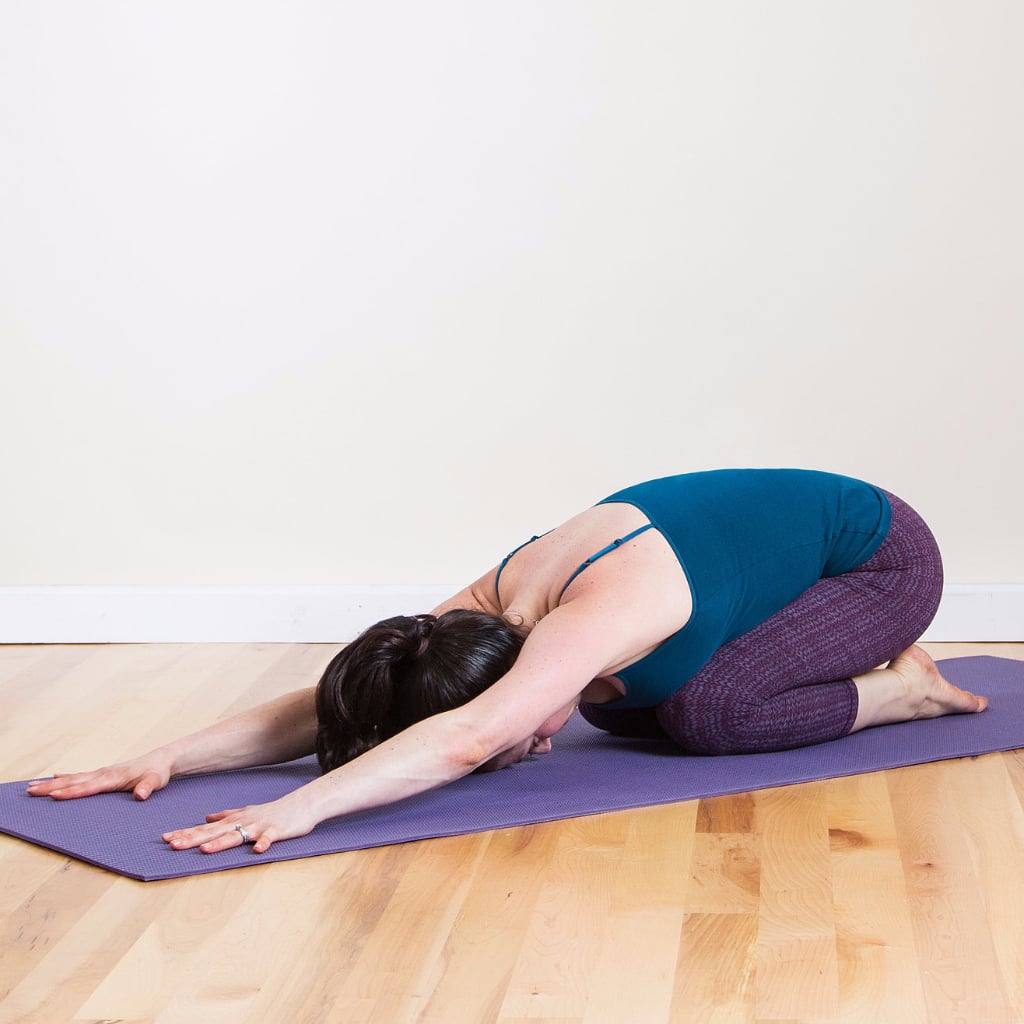
← Use Arrows Keys →
When you're suffering from a dull, tension headache, try these yoga poses before reaching for medication. They're a series of forward bends and reclining poses that will soothe your head and release tension from your neck. They'll also improve circulation, slow down your breath, and calm your mind.





When it comes to getting healthy, you probably already know that nutrition is just as important as exercise but did you also know your body requires different types of fuel for different types of movement? What you eat before and after your run, Pilates class, or strength training session can either fuel or sabotage your success. And no one wants their hard work to go to waste! Read on to discover why timing is everything when it comes to fueling your workouts and what you should eat before and after each type of workout.
You don’t want your stomach growling during exercise, but you don’t want to feel like you just ate Thanksgiving dinner either. Ideally, you want to fuel your body with healthy, nutritious foods that are no longer hanging out in your stomach when it’s time to work out. A high carbohydrate, low fat snack is ideal for most pre-workout snacks because it can easily be digested, plus it regulates your blood sugar.
As far as post-workout snacks go, the 60 minutes after you finish a workout is the perfect time to refuel with a combination of protein and carbs. That winning combo is what helps speed up your recovery time and replenishes your glycogen stores. A quick note: if you finish up your workout and it’s time for a main meal like lunch or dinner, go ahead and just eat that (no need to double up on a snack!)
Also, listen to your body. If you only workout for 20 minutes, you likely don’t need to bookend it with snacks on either side. The main goal is this: don’t go into any workout starving, but don’t feel the need to double up on meals before an intense class. Use tips to guide you in terms of what snacks are best for before and after each workout, and if you’re not hungry or just ate, no need to eat again before your workout. Make sense? Let’s move on to the best things you can eat before and after every type of workout, from running to Pilates and everything in between!
If you’re going for a twenty minute jog, you don’t necessarily need a pre-run snack, but a long-distance jaunt over 45 minutes merits some fuel about an hour before you hit the pavement. If you’re a coffee or tea drinker and it’s morning, you can also have a cup of coffee or tea during that timeframe, too. Be sure to recover after your run with a combination of protein and carbs. Here are some examples:

Strength training calls for plenty of protein afterwards, but how much you need to fuel up before does depend on how intense your workout will be. If you’re just doing a quick circuit workout of strength moves, you might not need anything beforehand. If it’s going to be a more intense strength session, you’ll want a little something an hour before and then protein afterwards. That sweet spot of anywhere from zero to 60 minutes after working your muscles is where you want to get a clean source of protein to help your muscles recover.

High intensity interval training requires a lot of energy; but you don’t want to overload your system before doing moves like plyometrics or other jumping movements. A light snack an hour before your HIIT workout is best. Afterwards, it’s important to replace energy stores (glycogen) and repair muscles with a 3:1 ratio of carbohydrates to protein after you’re done. The American Council on Exercise asserts that the right pre-and-post workout fuel for HIIT workouts can boost your energy and provide better results. Here are some stellar HIIT snack choices:

Both Pilates and Barre classes can sneak up on you with how hard you’ll be working. Both tend to focus on concentrated movements that build both muscle strength and muscle endurance. Depending on where you are between meals, use these pre or post snack ideas to fuel your class properly!

While in downward dog, nobody wants their stomach to be sloshing around. If you have anything before yoga, let it be light and give your stomach enough time to digest. Here are some ideas of what to nosh on before and after you say namaste:

No matter when you work out or the form of exercise you choose to do, stay hydrated. Water is essential to keep your body working safely and productively. Here are some of the health benefits of water:
No matter what workout you do, fuel it with clean food and plenty of water. You’ll get more out of your movement and bounce back ready for the next sweat session with ease!
This is a question I get asked a lot! What should I eat before and after a workout?! You also need to make sure you’re fueling your body properly for your workout and to give you the maximum results you’re looking for.

We’ve all been there.
If you’re an afternoon exerciser, you may go all day on the run–skipping lunch, or even worse not eating anything at all–then attempt to workout but totally run out of gas mid workout, exhausted and unable to finish.
If you’re a morning exerciser, your clothes are laid out and ready for your run or workout, but you try to go at it on an empty stomach and bam, you crash again. While some do great and actually prefer cardio on an empty stomach, I prefer to have a bit of energy stored up for the workout.
BEFORE your workout:
30 minute cardio
You could actually get away without eating anything before a 30 minute cardio, but if not, you’ll need a quicker digesting energy source such as:
30+ minute cardio
If you’re going to go longer than a 30 minutes such as a longer run, you’re going to need some quick digesting energy and some longer digesting energy (other carbohydrates) to sustain you for the longer workout or run.
Examples include:
These are my favorite oatmeal energy bars that are great pre or post workout!

Strength/Weight Training
You’ll need both quick and long digesting energy (good carb sources), but you’ll also need to add extra protein such as boiled eggs before your workout to fuel those muscles that will be working in overdrive.
Related posts:
Strength Training Workout for Runners
Weight Training Essentials for Women over 40
AFTER your workout:
After the workout is all about re-fueling! It’s best to eat within 30 minutes of your workout for the best results in feeding those muscles you’ve just torn down and replacing the all the energy you’ve used. Your muscles are hungry and they need to eat!
I always recommend a protein shake with fresh fruit after a workout (my favorite is this TLS Whey Shake). It’s quicker digesting and those muscles will really soak up all that goodness. Don’t be afraid of the sugar here either as that sugar helps to move that protein into the muscles and you’ll also need that sugar to replace your energy stores.
After a protein shake, you can then enjoy a full meal that includes:

Purchase one of my training plans where I’ll provide you with:
Beginner and Intermediate plans are available!
2017 Copyright. All Rights Reserved.
The Sponsored Listings displayed above are served automatically by a third party. Neither the service provider nor the domain owner maintain any relationship with the advertisers. In case of trademark issues please contact the domain owner directly (contact information can be found in whois).
Stretch your neck, arms, shoulders, chest, and back with these upper body stretching exercises. A set of static stretches to relax the muscles and improve joint range of motion.

Start your exercise routine with a 10 minute upper body warm up, continue with an upper body workout and finish with this set of stretching exercises.
1. Neck stretch: 30 seconds + 30 seconds. Tilt your head toward one shoulder until you feel the stretch in your neck and hold.
2. Shoulder stretch: 30 seconds + 30 seconds. Grasp one elbow and gently pull the arm toward the chest. Breathe slowly and exhale as you deepen the stretch.
3. Triceps stretch: 30 seconds + 30 seconds. To prevent soreness and tightening of the muscles, always stretch your triceps after any workout that includes pushing or pressing movements.
4. Biceps stretch: 30 seconds. Clasp your hands behind your back, rotate your hands and raise your arms until you feel the stretch in your biceps and chest.
5. Wrist stretch: 30 seconds + 30 seconds. Keep your elbow straight and bend one wrist with the help of the opposite hand until you feel a mild to moderate stretch in your forearm.
6. Chest stretch: 30 seconds + 30 seconds. Place your right palm on a wall and then slowly rotate your body to the left. Deepen the stretch as you exhale and then switch sides.
7. Upper back stretch: 30 seconds. Clasp your hands together, with the thumbs pointing down, round your shoulders and reach forward.

Enter your weight to find out how many calories you can burn doing these upper body stretching exercises:
When you need to do a flexibility routine, whether you just finished a workout or you are wanting to do some corrective stretching on your day off, you have a choice between two different styles. These two different styles are Active Stretching and Passive Stretching. The difference between the two is actually quite large considering they both are intended to do the same thing; increase flexibility.
Though we use the active form in this video lets cover the passive version first. Passive stretching is primarily using gravity or some other passive form like a machine to lengthen your muscles, ligaments, and tendons; think a Straight Leg Hang also known as a Standing Toe Touch. A Standing Toe Touch uses gravity to pull your upper body down towards the floor (when not engaging any other muscles) and is only as effective as the amount of leverage your upper body can place on your hamstrings (the back of the thighs). When done on a regular basis your body will increase its flexibility around the hip joint lengthening the muscles and tendons in the back of the thigh but it does nothing when it comes to control of that new range of motion.
Active Stretching on the other hand specifically engages the muscles that oppose the area you are wanting to increase flexibility in. What this does is allow your body to increase flexibility and strength simultaneously in regards to a joint's range of motion. This means that no matter how flexible you become you will alway have control over that range, lowering your chances of putting your body in a dangerous position. An example of active stretching similar to the example I gave above would be a Seated Toe Touch where you are engaging your hip flexors (the muscles in the front of the hip) and the quadriceps (the muscles in the front of the thigh) to keep your leg straight while tilting your hips forward towards your legs to lengthen and tighten the hamstring (back of the thigh) and glutes (butt muscles).
Not only does this form of flexibility training protect your joints more than passive stretching it also burns more calories. Because you are using your own muscle tissue to get into position, you have to constantly contract specific areas of your body for the entire duration of the stretch to keep the proper amount of tension. Because you are generally using only a few muscles at a time this ends up not being a huge calorie burner but it is still far better than the alternative and besides who is going to say no to a few more calories burnt throughout your day?
Stretches in this Routine
Overhead Tricep and Shoulder Stretch
Arm Cross
Chest Stretch
Rear Arm Raise (Down and Up)
Forearm Flexion and Contraction
Abdominal Bow
Lower Back Round
Oblique Lean (Left and Right)
Though this workout is not intended to be a big calorie burner it does happen to burn some calories. Depending on how hard you contract for each hold/stretch you can burn from 1 calorie per minute on the low end, up to 4 calories per minute on the high end. This will give you a range from 12 to 49 calories for this quick 14 minute stretching routine. Though it may not seem like much, every little bit counts when it comes to losing weight or keeping it off.
We made it really, really simple for people to make a blog and put whatever they want on it. Stories, photos, GIFs, TV shows, links, quips, dumb jokes, smart jokes, Spotify tracks, mp3s, videos, fashion, art, deep stuff. Tumblr is 394 million different blogs, filled with literally whatever.
Turns out that when you make it easy to create interesting things, that’s exactly what people do. All those great, random blogs your friends send you, those are Tumblr blogs. We’ll help you find and follow blogs like that, and we’ll help other people find and follow yours.
Once you follow a blog, all of its posts show up in your dashboard, just like you’d expect. See something great? Reblog it to your own blog. Add commentary if you like. Make it your own. Other people will do the same to your posts. That’s how you meet people here.
Seven post types to get you started. Your brain can do the rest. This thing is yours. Use it however you like.
Do you stretch after every workout? A good, post-workout stretch session will increase flexibility and range of motion, and help prevent workout injuries. On the other hand, skipping your cool-down stretch sesh can cause a build up of tension, hurt your posture, and result in unnecessary stiffness.
Stretching after a gruelling workout may seem like a drag, but it is pretty important. Don’t just perform a few half-hearted toe touches, either; your stretches should be deep and focused on the muscles you just used during your workout.
Try some of these stretches to get started, and you’ll begin to notice the difference quickly.
Stretching particularly tight areas after your workout is a great way to recover, but it is only part of a complete workout recovery. You should also cool down by walking or moving in place. You want to let your heart rate decrease slowly and keep moving to prevent needless soreness. Instead of hitting the lockers immediately after stepping off the treadmill, walk a few laps around the gym, drink some water, do some stretches, and maybe even use a foam roller. An established post workout recovery strategy will help prevent injury and soreness.
These are exactly what they sound like: stretches that keep you in motion. Dynamic stretching wakes up your muscles, improves their range of motion, and improves performance in physical activity. Try some of these stretches to keep yourself limber after your workout.
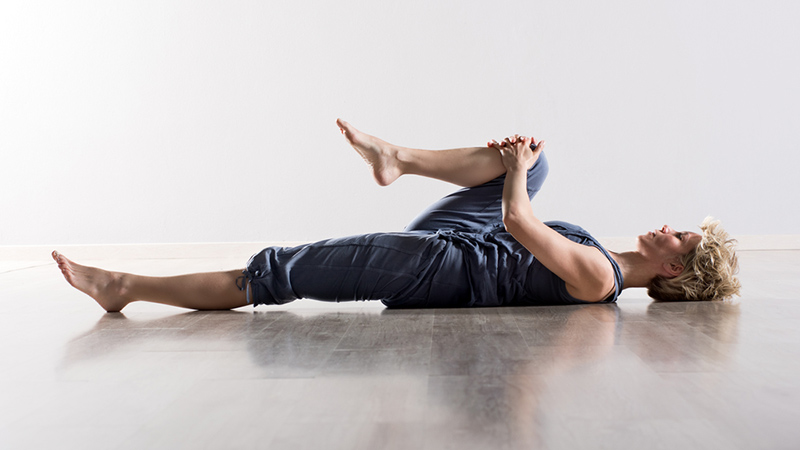
Stand with your feet about shoulder-width apart and back straight. Lift one knee up into the air so you’re standing on one foot, and grab the lifted leg by the shin for support. Bring your knee as close to your chest as you can, hold it for a second or two, then release it and lower your foot to the floor. Repeat with the other side.
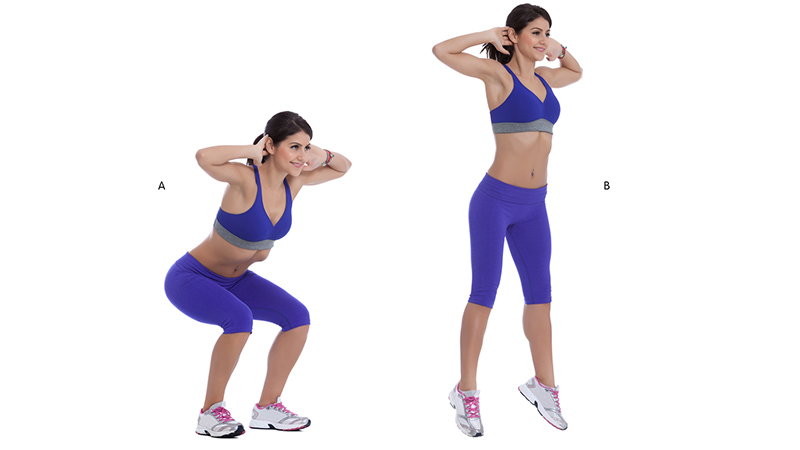
Begin by standing with your feet shoulder width apart. Hold your hands behind your head, then lower yourself into squat position. Jump upward explosively and land on your feet for one rep. This stretch will get blood flowing in your legs and lower body, and it is a great way to cool down. Just don’t overdo it. Rather than going quickly to accelerate your heart rate, do this one slowly, and really settle deep into the squat to emphasize the stretch.
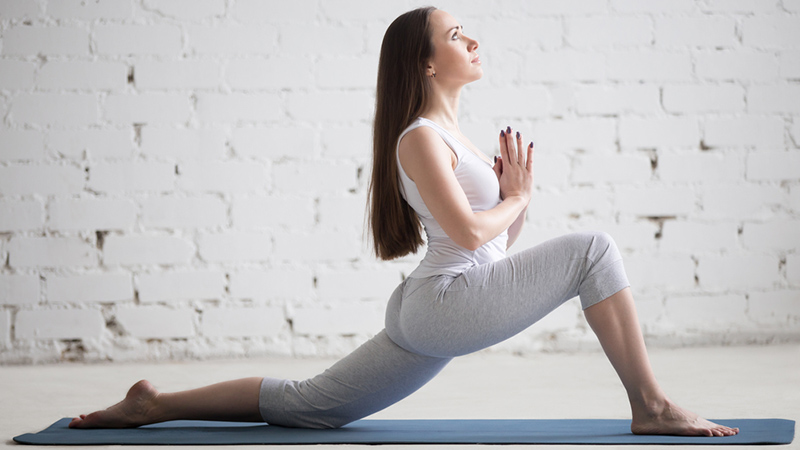
Start by kneeling on the ground with one foot forward. Keeping your back straight, use one arm to grab your ankle and pull it up toward your back as far as you can, until you feel a good stretch. Hold it for a moment, then release. Switch legs and repeat.
Of course, many of the best stretches are static. They usually involve holding a single position for 10 seconds or so, then releasing. These stretches will help lengthen your muscles and reduce soreness after a workout. Remember, static stretches are best done after a workout when your muscles are good and warm in order to avoid injury; never before.
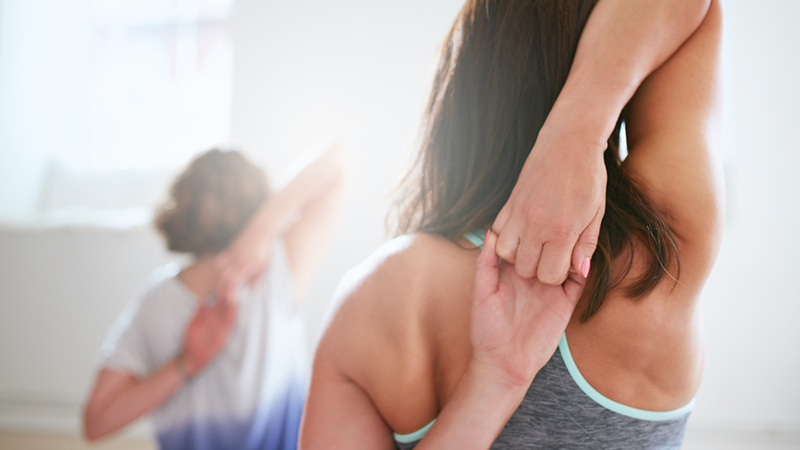
Start by either standing upright or sitting upright on a chair or bench. Lift your elbow up above your head with your hand behind your back. Grab your elbow with your other hand and pull it in toward your head gently. Hold the position for 10 seconds, then release. Repeat on the other side.
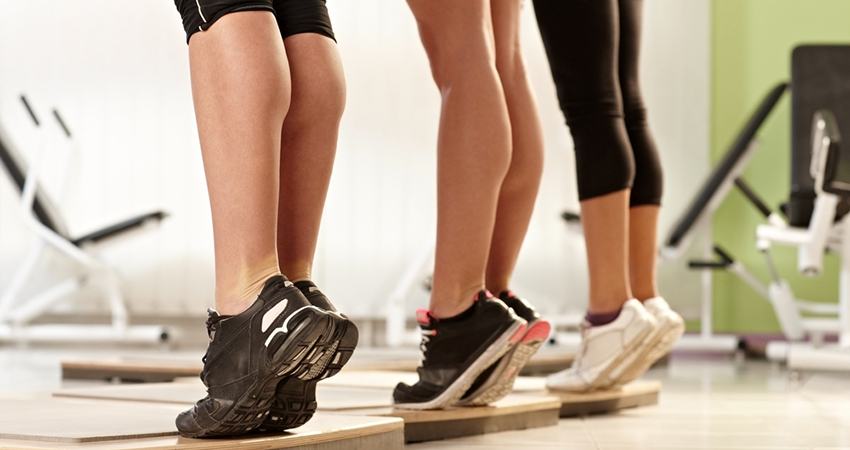
Stand on the edge of a step or bench, with the balls of your feet on the edge. Carefully drop your heels down and hold the position for 10 seconds while maintaining balance. Return to the starting position and repeat. You may need to hold a railing or other support during this exercise for balance; just make sure you’re putting all your weight on your feet.
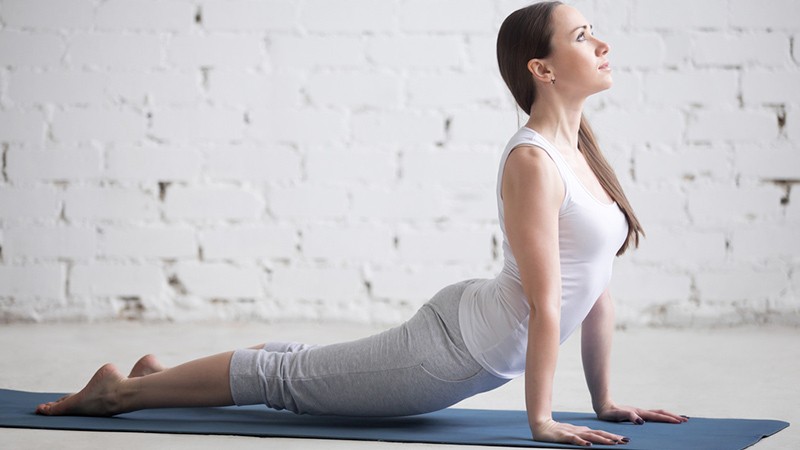
For this one you’ll need a yoga mat. Lie on your stomach with your toes extended out, and your hands flat on the mat next to your chest. Push through your hands and straighten your arms to lift your chest up as if you were a serpent. Your thighs and hips should also come off the floor, so your weight is resting on your hands and toes. Hold the position for 10 seconds, then lower yourself back to the ground.
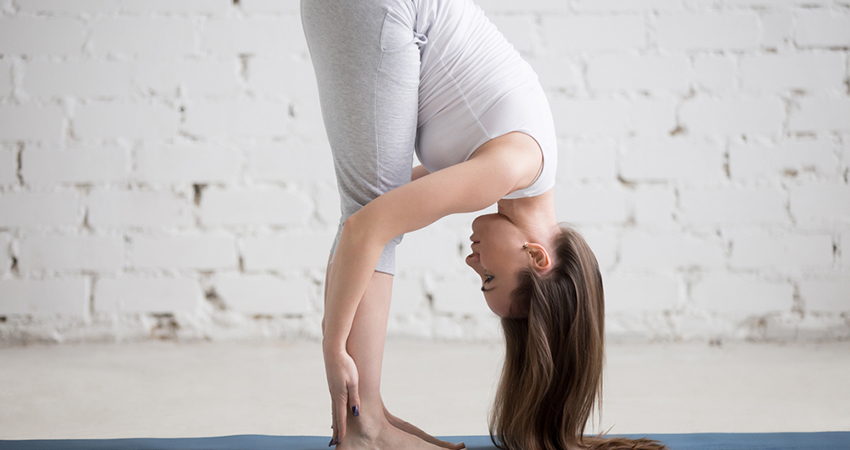
This is about as simple as stretches come. Start by sitting on the floor or a mat with your feet together, extended out in front of you. Keep your back straight, and bend forward, reaching for your toes. If possible, grab your feet with your hands. If not, stretch as far as you can, and hold the position for 10 seconds before relaxing.
After a workout, sometimes the last thing you want to do is hang around a gym and do post-exercise maintenance. However, putting the time in to properly cool down and stretch after a workout will go a long way toward reducing soreness, preventing injury, and increasing flexibility. Remember that you don’t have to do every stretch after every workout. Focus mainly on the major muscle groups you used, paying extra attention to muscles that are tight or sore. Don’t forget to indulge in other aspects of your post-workout routine as well: hydrate, mediate for a few minutes, consider rolling out sore muscles with a foam roller, and treat yourself to a hot steam shower or sauna. You will be glad you did.